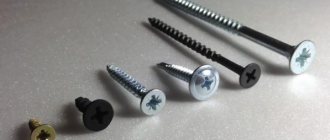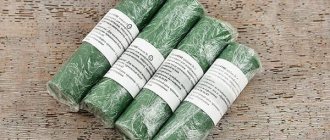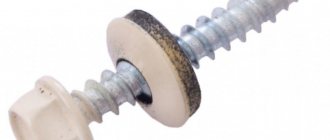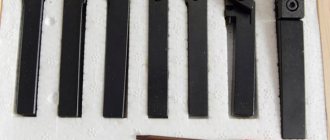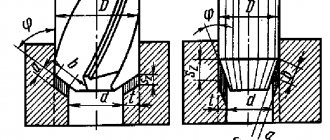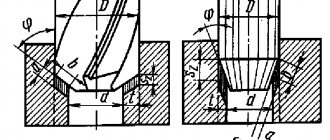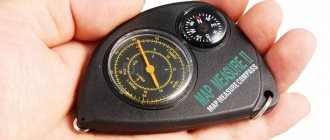How to choose a suitable self-tapping screw
Self-tapping screws are indispensable elements for fastening any type of household appliances, for example, an air conditioner. They are highly valued in the automotive and, more generally, mechanical fields for their grip and resistance.
If you're not sure which size to choose, buy a set of self-tapping screws in different sizes. Before purchasing self-tapping screws, you need to check criteria such as size, head shape and whether you need to use a drill.
The following 5 criteria must be taken into account:
- The material into which the screw will be inserted;
- Thickness and durability of the base;
- Thickness and weight of supported load;
- The material of the screw is preferably stainless steel on the outside.
- Possible limits of jerks and distortions during operation.
In general, it should be taken into account that the larger the diameter of the screw, the higher its resistance to tearing and deformation. It's the same with length: the longer the screw, the more it resists the applied force.
Features of use
Equally important is knowledge about the correct use of self-tapping screws. The options used in the process of working with metal can withstand heavy loads.
To ensure their maximum service life, the elements must be screwed into the material in a certain step.
High-quality screws for metal have a sharp tip, so there is no need to drill additional holes for them.
However, if the sheet thickness is more than 2 mm, you will still need to prepare a recess, but of a smaller diameter than the self-tapping screw. This will make the screwing process easier.
What is a metal self-tapping screw?
This is the name given to screws that are commonly used to join metal sheets and other similar materials. The other two types of screws that exist are the "wood screw" and the "metric thread" screw, which has no point and is secured with a nut. A threaded screw, also called a self-tapping screw, does not require a nut.
There is also a so-called self-drilling screw, which penetrates into sheets thanks to its tip, which resembles the tip of a drill. The self-tapping screw is widely used in roofs, PVC or aluminum windows and in general for metal structures. The parameters of the self-tapping screws comply with the European standard DIN 267 regarding the resistance of materials.
When choosing hardware, we must always consider what material we will use it on.
Main areas of application:
- Support and anchoring systems;
- Connection of metal profiles;
- Connecting metal sheets with wooden parts;
- Metal doors;
- Garage Doors;
- Roofing and facade cladding.
The self-tapping screw is characterized by several technical characteristics that determine its type:
- Head shape - three types of heads are possible;
- Type of step - carving, mainly on metal and wood;
- Diameter - expressed in mm;
- Length - expressed in mm, from under the head for round and flat heads and from above the head for flared ones;
- Optionally, graft and material.
Installation
Cost of work and materials
- The cost of one product coated with polyester is about 3-4 rubles, and with a polymer coating it will cost twice as much. Moreover, purchasing a package will be much cheaper than purchasing individually.
- With parameters of 4.8*29 mm, one thousand units will weigh about 5 kg.
Technology
- Before you begin attaching a metal structure, you must correctly cut the material (in the case of sheet metal).
- When using hardware with a sharp base, there is no need to make holes in the metal up to 2-2.5 mm.
- In other cases, it is recommended to prepare holes in advance that will be slightly smaller than the diameter of the screw itself.
The wider and thicker the metal sheets, the greater the load they bear on the structure itself. This means that the step between the fasteners must be reduced somewhat. Usually it is 400-500 mm. Preliminary quantity calculations are made from the same value.
Metal screws allow you to create durable structures that can withstand heavy loads. Correct selection of these connections is the key to reliability and long service life.
Self-tapping screw heads
The heads are:
- Expanding, used for soft metal, as the head enters it during screwing;
- Round, the head remains on the surface (screws for wood and metal);
- The head is flat and does not have a sleeve for screwing in with a screwdriver; it is tightened with a wrench and always remains on the surface.
To better understand the rating of any screw, let's take the HM10-60 screw as an example:
- H: means the head is shaped like a hexagon;
- M: means the pitch is ISO metric type (mechanical);
- 10: means the screw diameter is 10mm;
- 60: Screw length 60mm (under head).
UNIVERSAL HARDENED SCREWS SG
Universal galvanized steel (yellow/white) self-tapping screws for fastening various structures to wood, plywood, chipboard. When using a dowel, it is applied to dense materials.
| Designation | Quantity per package pcs | ~Weight kg/1000 pcs |
| 5С 2.5×10 | 50000 | 0.28 |
| 5С 2.5×12 | 50000 | 0.31 |
| 5С 2.5×16 | 40000 | 0.38 |
| 5С 2.5×18 | 36000 | 0.42 |
| 5С 2.5×20 | 36000 | 0.47 |
| 5С 2.5×25 | 24000 | 0.58 |
| 50 3.0×10 | 60000 | 0.42 |
| 50 3.0×12 | 50000 | 0.50 |
| 50 3.0×16 | 40000 | 0.57 |
| 50 3.0×20 | 35000 | 0.72 |
| 50 3.0×25 | 25000 | 0.82 |
| 50 3.0×30 | 18000 | 0.95 |
| 50 3.0×35 | 15 000 | 1.02 |
| 50 3.0×40 | 11 000 | 1.10 |
| 50 3.5×12 | 30 000 | 0.80 |
| 50 3.5×16 | 24000 | 0.90 |
| 50 3.5×20 | 18 000 | 0.95 |
| 50 3.5×25 | 16000 | 1.05 |
| 50 3.5×30 | 12000 | 1.28 |
| 50 3.5×35 | 10000 | 1.45 |
| 50 3.5×40 | 8 000 | 1.63 |
| 50 3.5×45 | 6500 | 1.90 |
| 50 3.5×50 | 5 500 | 1.98 |
| 504.0×12 | 25000 | 0.98 |
| 504.0×16 | 20000 | 1.00 |
| 504.0×20 | 17000 | 1.15 |
| 504.0×25 | 14000 | 1.43 |
| 504.0×30 | 12000 | 1.56 |
| 504.0×35 | 10000 | 1.87 |
| 504.0×40 | 8000 | 2.07 |
| 504.0×45 | 6500 | 2.40 |
| 504.0×50 | 5 500 | 2.56 |
| 504.0×55 | 5000 | 3.06 |
| 504.0×60 | 4500 | 3.57 |
| 504.0×70 | 3 500 | 3.60 |
| 50 4.0×80 | 4000 | 3.75 |
| 504.5×16 | 18000 | 1.35 |
| 50 4.5×20 | 13 000 | 1.60 |
| 504.5×25 | 10000 | 1.90 |
| 50 4.5×30 | 8 500 | 2.15 |
| 504.5×35 | 7500 | 2.43 |
| Designation | Quantity per package pcs | ~Weight kg/1000 pcs |
| 504.5×40 | 6500 | 2.94 |
| 504.5×45 | 5 500 | 3.32 |
| 504.5×50 | 5000 | 3.70 |
| 504.5×55 | 4000 | 4.08 |
| 504.5×60 | 3 500 | 4.46 |
| 504.5×70 | 3000 | 5.22 |
| 504.5×80 | 2000 | 5.25 |
| 50 5.0×16 | 10000 | 1.95 |
| 50 5.0×20 | 10000 | 2.05 |
| 50 5.0×25 | 8000 | 2.15 |
| 50 5.0×30 | 6000 | 2.71 |
| 50 5.0×35 | 5 500 | 3.20 |
| 50 5.0×40 | 5 000 | 3.58 |
| 50 5.0×45 | 4500 | 3.96 |
| 50 5.0×50 | 4000 | 4.34 |
| 50 5.0×55 | 3000 | 4.72 |
| 50 5.0×60 | 3 000 | 5.10 |
| 50 5.0×70 | 2 500 | 5.86 |
| 50 5.0×80 | 1 800 | 6.62 |
| 50 5.0×90 | 1 500 | 7.38 |
| 50 5.0×100 | 1 200 | 8.20 |
| 50 5.0×120 | 1 000 | 9.40 |
| 50 6.0×30 | 5 000 | 5.33 |
| 50 6.0×40 | 3 500 | 5.36 |
| 50 6.0×45 | 3200 | 5.53 |
| 50 6.0×50 | 2500 | 6.56 |
| 50 6.0×55 | 1 800 | 7.16 |
| 50 6.0×60 | 1 800 | 7.77 |
| 50 6.0×70 | 1 500 | 8.98 |
| 50 6.0×80 | 1 300 | 10.19 |
| 50 6.0×90 | 1 100 | 11.40 |
| 50 6.0×100 | 1 000 | 12.61 |
| 50 6.0×110 | 1 000 | 13.42 |
| 50 6.0×120 | 1 000 | 15.03 |
| 50 6.0×130 | 1 000 | 17.00 |
| 50 6.0×140 | 1 000 | 18.80 |
| 50 6.0×150 | 1 000 | 20.10 |
| 50 6.0×160 | 900 | 20.30 |
| 50 6.0×170 | 900 | 20.50 |
| 50 6.0×180 | 900 | 20.70 |
| 50 6.0×200 | 600 | 22.90 |
Self-tapping screws for polished soft metal and agglomerate
Such self-tapping screws have the property of being screwed in without preparing a hole. Pointed and threaded along the entire length, they do not damage the material when screwing.
They have a countersunk coated head and are made of bichromate (yellow screw), stainless steel or galvanized (silver).
Tips for choosing
Before you go shopping at a hardware store, you need to know a few rules for choosing.
- First, you need to accurately determine the material for which the screws are selected.
- Secondly, pay attention to the size of the parts.
- For materials with a small thickness, you should not purchase long and large-diameter models.
- They are more suitable for wood or thin metal sheets.
If you need to install a roof, choose only from roofing varieties. They can provide the required level of sealing of the holes.
Before purchasing, you must carefully inspect the screws. The surface must be smooth, without any curvature. You should not find even small irregularities on the thread. This can both ruin the material and cause a large amount of debris in the work process.
Products must be coated with special coatings. Protective coatings prevent corrosion. Most often these are galvanized or phosphated coatings. The tips can also be equipped with black sharp parts with a phosphated coating or with zinc plated ends in a light shade.
Metal screws
This is the type of hardware that combines the largest number of shapes, lengths, diameters, head types and different pitches. As a rule, the characteristics of metal screws are calculated by the manufacturer depending on the device or machine on which they are installed.
The material is very important from a mechanical use point of view as it determines the resistance to deformation, tearing, torsion, temperature and any form of pressure to which the screw may be subjected. If you need to replace one or two self-tapping screws, choose a completely identical type - the values are written on the head.
Depending on corrosion resistance, there are:
- Bichromate screws: they resist corrosion quite well if they are of high quality. Inexpensive ones, as a rule, lose their surface layer during operation (therefore they are easily susceptible to corrosion) and break when tightened too much. They are yellow in color and lose protection when damaged;
- Galvanized: Same concept as bichromates, the difference lies in the quality of the finish and the various signs of wear that appear after use. Its corrosion resistance is medium and its color is silver;
- Phosphated screws: black. They are quite durable and have good corrosion protection;
- Chrome plated looks the same as galvanized plated and has the same level of durability. Corrosion resistance depends on processing and signs of wear after use;
- Brass Screws: Brass is intended for interior use in structures and often in joinery where wood and metal are joined. Brass has low corrosion resistance, turns green and is very expensive;
Stainless steel screws - ideal for outdoor use. Stainless steel is resistant to corrosion. There are two main options: A2, which is more common and cheaper, and A4, which is a molybdenum alloy, which provides acid protection and therefore greater stability.
What types are there?
With a press washer. High-quality self-tapping screws with a drill and a press washer are distinguished by a trapezoid-shaped head and a wide shoulder. Due to its volume, the cap presses the material quite tightly and firmly. The deep lug prevents the bat from slipping off. The diameter of this product is 4.2 mm.
There are two types of self-tapping screws with a drill:
- Pointed. Sheets of metal, 0.9 mm thick, are fastened together. No additional drilling required.
- Drill-tip. Can fasten sheets up to 5 mm thick. Excellent for interior installation work.
Cheaper options are usually used for domestic purposes. They differ in the flatness of the surface and the rounding of the head. A thin zinc coating does not protect the self-tapping screw from rust.
The shallow depth of the pin and the slipping of a screwdriver or bit can cause chips or scratches on the surface of the materials. In addition, among the cheap options there are often defects.
Self-tapping screws for sheet metal
Sheet metal hardware is similar to wood screws, but is made of a different material (much stronger) and has a special tip.
It is highly recommended to make a hole or a clear mark with an awl before inserting the screw to make it easier to screw in.
- Primarily used on thin sheet metal, soft metals (such as aluminum) and possibly plastic.
- Their main property is that they can pierce the material when screwing. Their threading is the same as that of wood screws, except for a different tip (similar to a drill).
- Self-tapping screws can, depending on the application, have a countersunk, rounded or hexagonal head.
- Coupling for countersunk and rounded heads - Philips, Posdriv or hexagonal.
Roofing screws with drill bit with EPDM gasket
This type is intended for outdoor work. These are fastening materials to metal structures, as well as to wooden sheathing.
Compressing the washer when screwing in leads to sealing of the recess. The head may have a paint coating to remain protected from corrosive processes. The washer is pressed against it during installation.
Roofing self-tapping screws - a drill with a pointed end - are necessary for securing the soft roof to the base. The reduced drill involves the use of corrugated sheeting to the surface of the wooden sheathing during installation work. An enlarged drill is used to firmly secure the decking to the metal base.
Varieties by area of use:
- For different types of wood and plastic. The difference from others is the rarity of the step in the carving. For a tree, they look like a trunk with very sparse carvings. The hat is easily hidden in the material without interfering with further work. A rare step is necessary to avoid the wood from crumbling.
Black parts are used to attach drywall and fasten wood elements together without additional drilling.
Models in yellow and white colors are suitable for fastening material with drilling. Do not rust, suitable for fittings.
- For sandwich panels. Fastening to metal occurs. Such elements are capable of independently drilling a sheet of metal with a thickness of 12-14 mm. Hex head, turnkey. The kit includes a washer along with a rubber gasket. This helps ensure the holes are waterproofed. The thickness of the materials varies from 1.5 to 12 mm.
- For drywall;
- For metal;
- For window profiles.
Types of carving
- Large. It runs along the entire trunk of the product, there is a rare step. Suitable for working with soft materials: wood, plaster, plastic.
- Average. Characteristic of universal self-tapping screws. They fix most materials.
- Asymmetrical. Typically applicable in the production process. In everyday life it is useful for assembling furniture.
- Notched variable. Acts as a fastening when working with brick or concrete surfaces, without using dowels.
Self-tapping screws for fasteners and strips
Fasteners are metal structures that are attached to external doors, gates and shutters and act as hinges. They are supported by hinges that can be screwed into the wall or screwed.
- To fasten the planks, self-tapping screws are used, selected depending on the material of the supports (wood, aluminum, PVC) and the color of the metal parts.
- Generally speaking, the aesthetic criterion is taken into account when determining the shape of the head. You will find flared heads, large round heads, round heads.
- Their threads have a large pitch, and the tip is adapted to the support material.
The most famous self-tapping screws are those with a semicircular head and a square head.
What affects quality
There are many factors that, to one degree or another, influence the quality of construction parts. However, the main ones are the following:
- The material from which the elements are made;
- Manufacturing technology and accuracy of its adherence.
In addition, it is better to purchase self-tapping screws, as well as other working materials, from trusted companies that have managed to establish themselves in the market. Now there is a big risk of falling for cheap, low-quality fakes.
It is usually better to opt for well-known brands and specialty stores. In addition to confidence in quality, you will receive professional advice from the staff.

